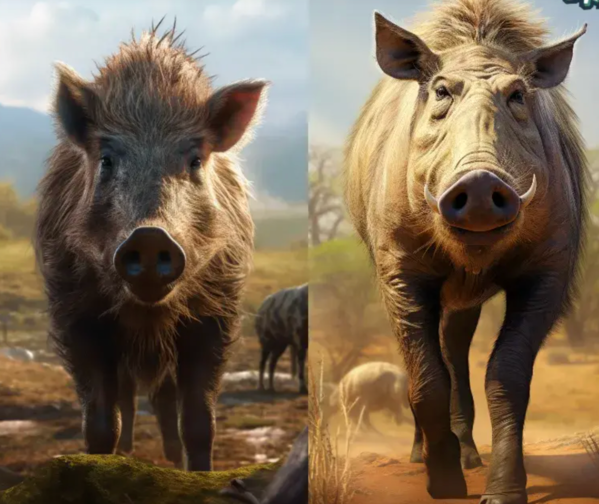When it comes to wild pigs, two species stand out: the wild boar and the warthog. Both are fascinating animals with unique characteristics, but they differ in many ways. In this article, we’ll compare wild boars and warthogs across several categories to see who comes out on top. We’ll delve into their physical traits, habitat, behavior, diet, and more, providing a comprehensive look at these intriguing creatures.

Wild Boar: The wild boar (Sus scrofa) is a species native to Europe, Asia, and North Africa. They are known for their adaptability and have been introduced to many other regions, including North America.
Warthog: The warthog (Phacochoerus africanus) is native to sub-Saharan Africa and is easily recognized by its distinctive facial warts and tusks.
| Feature | Wild Boar | Warthog |
|---|---|---|
| Scientific Name | Sus scrofa | Phacochoerus africanus |
| Habitat | Forests, grasslands, and wetlands | Savannas, grasslands, and woodlands |
| Physical Size | 150-300 lbs (68-136 kg) | 110-250 lbs (50-113 kg) |
| Length | Up to 6.5 ft (2 m) | 3.5-5.5 ft (1.1-1.7 m) |
| Color | Dark brown to black | Gray to brown |
| Face | Flat with smaller tusks | Pronounced warts and larger tusks |
| Social Structure | Solitary or small groups | Live in sounders (groups) |
| Diet | Omnivorous; eats roots, fruits, and small animals | Herbivorous; primarily grasses and roots |
| Reproduction | Breeding season in late winter/spring | Year-round breeding; high maternal care |
| Lifespan | 10-14 years in the wild | 12-18 years in the wild |
| Conservation Status | Least Concern | Least Concern |
Wild Boar: Wild boars have a robust and muscular build with a flat face. Their tusks are smaller compared to those of warthogs but are still formidable. Their fur is coarse and can vary from dark brown to black.
Warthog: Warthogs are known for their distinctive facial warts and longer tusks, which can grow up to 10 inches (25 cm). They have a stocky body with a bristly coat, usually gray or brown. The tusks and warts are more pronounced in males, especially during mating season.
Wild Boar: Wild boars are highly adaptable and can thrive in various environments, including forests, grasslands, and wetlands. They can be found in temperate and tropical regions across the globe.
Warthog: Warthogs prefer open savannas and grasslands in sub-Saharan Africa. They often use abandoned burrows of other animals for shelter, which provides protection from predators and harsh weather.
Wild Boar: Wild boars are generally solitary but can form small groups, especially females with their young. They are known for their intelligence and are capable of using tools, such as digging up roots.
Warthog: Warthogs are social animals that live in groups called sounders, typically consisting of several females and their young. Males are often solitary or form temporary bachelor groups. They communicate using a variety of vocalizations and body language.
Wild Boar: Wild boars are omnivores, meaning they eat a wide range of foods, including roots, fruits, nuts, and small animals. Their diverse diet allows them to adapt to various habitats.
Warthog: Warthogs are primarily herbivores, with a diet mainly consisting of grasses, roots, and tubers. They are known for their unique grazing behavior, often eating while on their knees to reach grass and roots.
Wild Boar: The breeding season for wild boars occurs in late winter or early spring. Females typically give birth to litters of 4-6 piglets after a gestation period of about 3-4 months.
Warthog: Warthogs can breed year-round, with females often caring for multiple piglets at once. After a gestation period of about 5-6 months, they usually give birth to 2-4 piglets.
Both wild boars and warthogs are classified as "Least Concern" by the International Union for Conservation of Nature (IUCN). However, they still face threats from habitat loss and hunting in certain regions.
When comparing wild boars and warthogs, it's clear that each species has unique strengths and adaptations suited to their environments. Wild boars are more adaptable and have a broader diet, while warthogs are social animals with distinct physical features that help them survive in the African savannas.
In a head-to-head scenario, it's not a matter of one winning over the other; rather, each animal excels in its own way. Whether you are fascinated by the wild boar's intelligence and adaptability or the warthog's unique appearance and social structure, both species are remarkable in their own right. Understanding these differences enriches our appreciation of the animal kingdom and the diversity of life on our planet.
animal tags: Wild-Boar Warthog
We created this article in conjunction with AI technology, then made sure it was fact-checked and edited by a Animals Top editor.